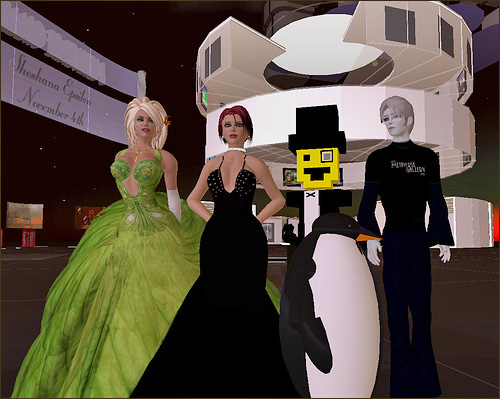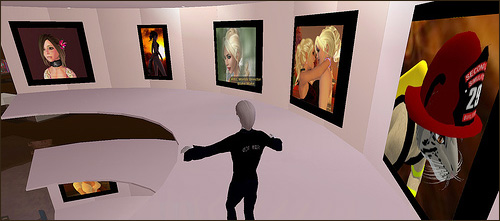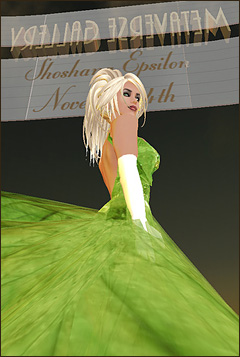Stills from Subdivided on Flickr
November 19th, 2006A lot of new stills from Subdivided have been uploaded to flickr.
A lot of new stills from Subdivided have been uploaded to flickr.
The Blog for Subdivided is up. I’ll put most of the Subdivided news related to screenings, festivals, broadcasts, talks, etc there. I’ll also be putting regular updates on the participants in the film, especially Robert Putnam, Andres Duany, and James Kunstler, who are very active. Subdivided will premiere in January on PBS Station KERA, and the DVD will be available then as well.
It’s been a long road…

The Metaverse Gallery in Second Life opened this weekend. It was the most fun I think I’ve ever had at an art opening. It was very well attended.
A lot of people go in to Second Life, walk around a bit, look at all the ugliness, porn, gambling, and then say something like “I tried it but it was boring.” And for the most part, they are right. A lot of these people are used to games, where the expectations and rules are set. In Second Life you have to work pretty hard to make compelling places and created meaningful events. And that’s just what the Worlds Lab team did - they worked really hard for several months.
The Metaverse Gallery in many ways is the culmination of a series of Online Worlds courses and research that has taken place over the last year at UT Dallas. What we’ve come to is the idea that Second Life is an awkward, temporary, highly flawed, difficult, very early version of
something that will evolve in a most painful manner into an immersive 3D metaverse. At the moment, it’s the only place to really test out ideas about how to do things other than games in participatory 3D spaces. And I’ve been adamant in my belief that in very short order the non game 3D shared spaces will eclipse the game spaces. This is where a lot of people have it wrong in thinking that the game spaces will expand and merge somehow. Not a chance. But that’s a different topic I’ve written about elsewhere.
For us, we’ve given a lot of thought to the the structures themselves, and what kind of art work we wanted to show. Our view, hotly debated in SL circles, is that rather than just dumping things from the physical world in to SL we need to build environments that suit the structure and rules of the online world itself. The same thing goes for the art - why scan in things from the 1st world or from the 2D Internet when you can show work made in world?

The Metaverse Art Gallery is basically an example of our thinking. We chose to build a floating platform without stairs or other gravity dependent details. Some of the walls are transparent from one side and opaque from the other - try that in fleshspace. The entire structure floats on a semi-transparent platform. For the inaugural artist, we chose someone who is an artist in SL, and makes her work there. In some ways she is very traditional - she makes portraits of other avatars. It is very accessible work, which is also on purpose. Obtuseness for its own sake helps no-one.
The building will evolve over time as our team, their skills, and our thinking matures. In this show we included a small area where chat conversations are re posted Jenny Holzer style on the floor. A kind of reactive public sculpture. We’re also talking a lot about dynamic architecture (or really, dynamic UI). Most of the structures on the island will eventually incorporate dynamic elements that respond to several kinds of inputs: avatars in the immediate surroundings, in world data such as time and communications, and external web data such as database feeds from RSS and XML (stock market, weather, blog entries, flickr postings, etc). All of these combine to do what is impossible in the 1st world: structures that change dynamically based on a set of external conditions.
We’re thinking a lot about these and other ideas and the experiments that we are doing can be viewed in real time in the research area on the island. One of the projects is, at the moment, called “the proximity noodle.” It’s a pretty simple set of objects that bend toward you when you approach. Now on the one hand I despise “gee whiz” art - art basically art made to demonstrate some technical achievement. There’s quite a bit of this in SL - “sculptures” that wave around in the “wind” for example. You look at them and say to yourself “gee whiz!” And that’s the end of it.
And while we may get close to geewhiz art in the coming months I hope we push it well beyond and into expressiveness, or simply play. I think some of the work in metaverse spaces will be more about mature play and surprise than the contemplative befuddlement you see visitors engaged in inside many a traditional art exhibit. This is important, because even though these places are not games, the element of experimentation and play is certainly present. We don’t want to have to pretend to be serious. If there is any place to knock some holes in the often elitist, noxious air of contemporary art it is here.
 We intend to continue to develop and take seriously the idea that the conventions of the metaverse are far from developed. Some have come from gaming, the rest are in development, and mostly invisible. One thing that is not helping is all the corporations and educational institutions building real world structures in Second Life. It’s seriously missing the point, and I think all the new design firms who are doing all this building need to do some client education.
We intend to continue to develop and take seriously the idea that the conventions of the metaverse are far from developed. Some have come from gaming, the rest are in development, and mostly invisible. One thing that is not helping is all the corporations and educational institutions building real world structures in Second Life. It’s seriously missing the point, and I think all the new design firms who are doing all this building need to do some client education.
The opening was a first, and really felt like something. This is the bar for 3pointD space events. Most of them are just frustrating, stupid, or, as many have found, boring.
But if you want a meaningful experience, you are going to have to create one.
Here’s some reference links:
Go to The Metaverse Gallery Now (Second Life required), or check out the pics on flickr.
Press Coverage:
SLNN posted this review of the event, and the Dallas Morning News ran a story on it as well, excerpt of it is here. There was also a bit in Glass Tire, and my friend Dennis Hollingsworth gave us a visit (a little early!)
Artist: Shoshana Epsilon | UT Worlds Lab Team members Christi Nielsen (”Juliette Cordeaux” who curated the show) Russell Smith (”Rusmi Taka”), Jeff Martini (”Jerry Tones”), & Steve Petterborg. More about the lab at UT Dallas Online Worlds Lab.
 I will be giving a talk on the emerging metaverse, art, and related topics this Saturday afternoon at the Modern Art Museum of Fort Worth. I’ll be previewing the upcoming art show on the ATEC Second Life Island. The talk is part of the TexElectronica New Media Art event hosted by UNT. Tom Linehan and Frank Dufour from UTD are also scheduled at the event.
I will be giving a talk on the emerging metaverse, art, and related topics this Saturday afternoon at the Modern Art Museum of Fort Worth. I’ll be previewing the upcoming art show on the ATEC Second Life Island. The talk is part of the TexElectronica New Media Art event hosted by UNT. Tom Linehan and Frank Dufour from UTD are also scheduled at the event.
So you are in college and looking for a good gig. What do you do in the age of GooTube? You make a video of course. And you claim you can serve a tennis ball 140 mph and bench press 495 pounds. Wait, no, maybe you shouldn’t do that.
Actually I don’t think Yale student Aleksey Vayner knew he was living in the age of web 2.0 and GooTube - his video was part of a supposedly confidential application to UBS for an investment banking job. If your video is digital, you should assume everyone will see it, at least until we have better permission layers on Internet media.
Social networks can connect you and make you popular, but they can also bring you 15 minutes of shame.
The new EMAC Site is up. Just a default template for now but I’ve been pretty good about posting there in the past week or so - mostly for the UTD Arts & Technology community but anyone who reads this blog will probably find it interesting.
It’s mostly quick bits of things with sprinklings of commentary. The site is a group effort and there are several grad students contributing. EMAC stands for Emerging Media & Communication and is the new area I started this year inside the Arts & Technology program at the University of Texas and, happily, it’s really taking off.
Andres Duany: The New Civic Art
Originally uploaded by Dean Terry.
The Cover of Andres Duany’s new book The New Civic Art
Duany is featured in the documentary film “Subdivided” by yours truly.
Silicon Valley has sequelitus even worse than Hollywood. It’s kind of pathetic.
This capture from Skype, courtesy
of factoryjoe,
says it all.
![]()
Last week I was at the Austin Game Conference, and, other than my own presentation, pretty much missed everything. Some have asked for my slides from the talk, so here they are. There are many notes and anecdotes missing, but you should be able to glean something from it.
I may not have attended many of the talks, but I did have spies. Other UTD Virtual Worlds Lab folks were there and they gave me reports on many of the panels. One interesting thread was the “metaverse” talk which I’ve been tracking for some time now. Much of it, granted, is already starting to sound hype-filled, but there are important ideas to discuss. There are competing visions about how the metaverse will evolve (if at all).
One idea that I think deserves to be deflated is that, by some magic transformation, the game industry itself will create an extensible 3D universe that moves beyond games and connects a diverse set of 3D worlds. I have doubts that, in any conscious manner, that this will be the case. The game developers have enough problems creating new games that will compete in a very tight marketplace. And, with a few exceptions, they get pretty uncomfortable once the talk begins to move beyond games. The talk about casual games, serious games, and the ill-defined metaverse were efforts to expand the space but stay with in their comfort zone.
My bet is that the extensible, user generated 3D worlds that move beyond games will come from outside the game industry and more importantly, they will eventually eclipse it.
In several sessions the WOW vs MySpace stat came up: 1 million US WOW players vs 110+ million MySpace users. One of the points that Monica Evans and I were trying to make is that MMORPG games need to take much more seriously the social aspects. Monica, who is a PhD candidate at UT Dallas, argued that the social space that exists within and around the game is actually the most important aspect. I argued, among other things, that game developers need to take look at the web 2.0 social network space for ideas about how to create tools for community building. They are very different ways of producing, however. Games are top down productions where all the content is created by the game company. Social Networks are made up of a set of tools that enable participants to create their own content. One designs the experience and the other designs the tools that allow people to create their own experiences. In the 3D space, Second Life is the best know example of this.
Once you leave the confines of game worlds and game related interactions the conventions for new forms of navigating and communicating are non-existent. In game worlds you can model whatever world you are emulating: fantasy, sci-fi, etc. When you move in to 3D spaces for other purposes - an “art gallery” or “office space” for example - basically the only option is to fall back on real world examples. And that’s where not only the whole thing falls on its face, but also where the opportunity lies.
The opportunity is to create new kinds of worlds that vary from imaginative creations beyond the narrow game genres to very practical spaces that extend and even create new areas of the economy.
The problem is that no one seems to be leading the charge. Some new, consumer oriented tools would help. What we have now are game development tools, Second Life and a few other similar worlds, and Multiverse. These are developer and early adopter tools. My second bet, as I presented in my talk, is that the “multiverse” will develop out of lots and lots of small, individually created and interconnected social worlds, rather than from the expansion and connecting of larger, game-like worlds.
What we don’t have yet are simple tools that allow individuals and groups to create these stand alone worlds. For lack of a better name I call it “iWorld” in reference to the Apple suite of software that is so easy to use. That is the way it needs to work. What iMovie is to Final Cut, iWorld would be to the current crop of developer tools (even though they are a far cry from the maturity and elegance of Final Cut Pro). I should be able to create a virtual room, put stuff in it, and invite friends over. Then I should be able to connect it to other rooms and larger spaces.
Games take social interaction as a secondary consideration. And you really can’t blame them: creating a good game is very hard. But they just need to talk to their own, most ardent fans to find out just what’s missing. That’s just what I did several months ago in Atlanta at the FanFaire for Sony’s Everquest and other properties. What I learned is that without exception among the thirty or so interviews and discussions I had, that the social connection was more important than the game. The players loved the game, but they really needed the connection to other people. This need is the very serious part of game worlds, and game companies are not well equipped to deal with it. It’s not their area of expertise.
I came away from the FanFaire event a bit sad. I met several people who had driven alone from hundreds of miles away to meet fellow gamers. The longing for friendship and connection in the real world was palpable. In this context, among like-minded peers, they were comfortable, and it felt like an instant community was formed during those three days. After it was over they went back to using Everquest as a social network, even though it is not intended or optimized for this purpose. The sadness left me thinking that these people need something better. And what about the much, much larger group that is not interested in the fantasy and sci-fi worlds the game industry offers? I think they also need 3d social worlds. Where are they? Second Life is a start, but it has serious flaws that will keep it from becoming the model for the metaverse (economic model, a single map, private ownership & governance, a dedication to emulating reality, etc.) More on this later.
I think it is highly unlikely that the metaverse will emerge from the gaming world. An expanded 3D world will more likely emerge from Internet developers who look look to games for inspiration in the areas of real time interaction and immersive 3D space. There are interim steps to be made, however. I’ll leave that to your imagination…